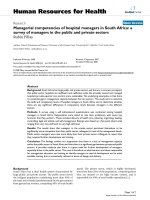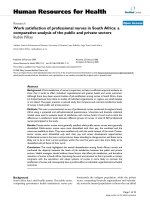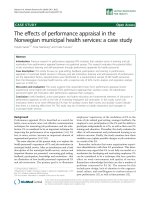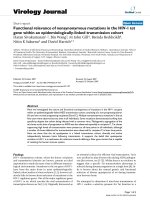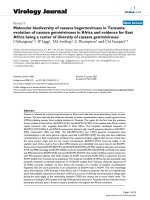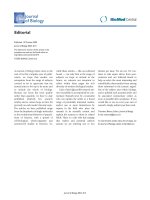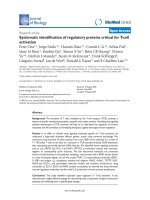Báo cáo sinh học: "Adaptative significance of amylase polymorphism in Drosophila. III. Geographic patterns in Drosophila subobscura tissue-specific expression of amylase in adult midgut" pot
Bạn đang xem bản rút gọn của tài liệu. Xem và tải ngay bản đầy đủ của tài liệu tại đây (412.12 KB, 8 trang )
Original
article
Adaptative
significance
of
amylase
polymorphism
in
Drosophila.
III.
Geographic
patterns
in
Drosophila
subobscura
tissue-specific
expression
of
amylase
in
adult
midgut
M
Andjelkovi&jadnr;*
M
Stamenkovi&jadnr;-Radak,
M
Sekulic,
M
Milanovi&jadnr;
University
of
Belgrade,
Institute
of
Biological
Ilesearch,
29
Novembra
1l,2,
11000
Belgrade,
Yugoslavia
(Received
8
March
1990;
accepted
10
March
1991)
Summary -
Eight
natural
populations
of
D
subobscura
(Collin)
were
studied
for
genetically
controlled
variation
in
tissue-specific
expression
of
a-amylase
enzyme.
Polymorphism
for
amylase
tissue
variation
in
the
midgut
was
found
to
be
present
in
natural
populations.
This
type
of
phenotypic
variability
showed
intra-
and
interpopulation
variability.
The
geographic
variation
in
a-amylase
midgut
activity
patterns
of
gene
expression
was
found
to
be
uncorrelated
with
allozyme
variation
at
the
structural
locus.
There
was
no
detectable
correlation
of
activity
patterns
in
the
anterior
midgut
with
those
in
the
posterior
midgut.
Drosophila
subobscura
/
a-amylase
/
tissue-specific
expression
/
inter-
and
intrapop-
ulation
variability
Résumé -
Signification
adaptive
du
polymorphisme
de
l’amylase
chez
Drosophila.
III.
Variation
géographique
de
l’expression
de
l’amylase
dans
l’intestin
moyen
de
l’adulte
de
Drosophila
subobscura.
Huit
populations
naturelles
de
Drosophila
subobscura
ont
été
étudiées
et
se
sont
révélées
polymorphes
pour
l’expression
tissulaire
de
l’amylase
a
dans
l’intestin
moyen.
Il
existe
un
polymorphisme
intra-
et
interpopulationnel.
Il
n’existe
pas
de
corrélation
entre
l’activité
amylasique
dans
la
partie
antérieure
et
postérieure
de
l’intestin
moyen,
pas
plus
qu’avec
le
polymorphisme
au
locus
structural.
Drosophila
subobscura
/
amylase
a
/
expression
tissulaire
/
variabilité
inter-
et
intra-
population
*
Correspondence
and
reprints
INTRODUCTION
A
number
of
authors
have
suggested
that
changes
in
genetic
regulation
are
of
major
importance
in
eukaryotic
evolution
(for
references
see
Hedrick
and
McDonald,
1980;
Templeton,
1981;
McIntyre,
1982;
Paigen,
1986).
Many
tissue-specific
enzyme
pattern
differences
may
be
due
to
the
effect
of
variants
at
regulatory
loci.
One
of
the
most
extensively
studied
regulatory
gene
systems,
that
affects
a
tissue-specific
enzyme
pattern
is
a-amylase
expression
in
Drosophila
(Powell
and
Lichtenfels,
1979;
Doane,
1980;
Powell
et
al,
1980).
We
have
started
to
study
intensively
Drosophila
subobscura
for
genic
and
phenotypic
polymorphism
of
a-amylase
and
its
tissue-specific
expression
in
adult
midgut;
hence,
in
the
present
paper
the
geographic
variation
of
these
types
of
polymorphism
is
presented.
MATERIALS
AND
METHODS
An
analysis
of
tissue-specific
midgut
a-amylase
activity
pattern
(MAP-type)
was
undertaken
in
D
subobscura
adults
from
8
natural
populations
(details
on
these
collections
are
given
in
Andjelkovi6
et
al,
1987).
All
flies
were
reared
on
standard
cornmeal-sugar-agar-yeast
food
medium
for
one
generation
before
determining
midgut
amylase
activity.
First
generation
fresh
sampled
flies
from
nature
were
studied.
The
method
described
by
Abraham
and
Doane
(1978)
was
used
to
prepare
dissected
midguts
of
3-5
d-old
adults
and
to
determine
their
amylase
activity.
The
activity
could
be
expressed
in
3
regions
of
the
anterior
(AMG)
and
2
regions
of
the
posterior
(PNIG)
midgut.
The
presence
of
activity
is
indicated
by
a
number
and
absence
by
zero
(eg,
123
10
means
activity
in
the
3
regions
of
AMG
and
region
1
of
PMG,
but
absence
of
activity
in
region
2
of
PMG).
The
range
of intrapopulation
phenotypic
variability
is
given
by
Shannon’s
diver-
sity
index
and
for
testing
the
significance
of
differences
in
phenotypic,
frequency
dis-
tributions
between
populations
7-divergence
analysis
was
used,
derived
from
Shan-
non’s
entropy
function
(Orloci,
1970),
given
by :
In
this
expression
fj
.,
f.
j
and
f
signify
the
ith
phenotype
(row)
total,
the
jth
locality
(column)
total,
and
the
grand
total
for
all
phenotypes
(or
all
localities),
respectively.
The
number
of
species
is
r.
Twice
the
value
of
I
is
an
approximation
to
X2
with
(r -
1)(c -
1)
degrees
of
freedom.
RESULTS
Table
I
presents
the
frequencies
of
midgut
activity
pattern
(MAP-types)
in
8
natural
populations
of
D
subobscura.
In
the
data
both
sexes
were
combined,
since
no
significant
differences
have
been
detected
between
male
and
female
patterns
(Stamenkovi6-Radack
et
al,
1987).
The
number
of
theoretically
possible
patterns
of
amylase
midgut
activity
in
D
subobscura
is
32,
but
the
MAP-type
AMG-000
PMG-00
has
not
been
detected
so
far.
Other
midgut
activity
patterns
occurred
with
different
frequencies
in
populations
analyzed
in
this
paper.
In
7
of
them,
the
most
frequent
MAP-type
was
AMG-123
PMG-12,
whose
frequency
was
in
the
range
from
33.3 -
62.6%.
In
the
Kuzni
Do
population,
the
most
frequent
MAP-type
was
AMG-100
PMG-00
(34.7%).
Except
for
those
2
MAP-types,
all
others
appeared
with
lower
frequencies
in
populations
studied.
There
were
5
MAP-types
(123
10,
123
00,
120
12,
120
00,
100
10),
with
frequency
of
5%
and
higher,
in
some
populations
and
3
MAP-types
(123
00,
120
12,
100
12),
which
occurred
only
in
a
number
of
populations
with
a
frequency
of
10%
and
higher.
As
the
genotypes
of
different
MAP
types
were
not
known,
it
was
not
possible
to
estimate
gene
frequencies
or
gene
heterozygosity.
Therefore,
the
Shannon
diversity
measure
(diversity
index)
was
used.
The
value
of
H
showed
that
there
were
dif-
ferences
in
the
degree
of
polymorphism
between
the
populations.
These
differences
reached
a
ratio
as
great
as
1.7
in
the
case
of
the
Popovica
population
(the
highest
H
value)
with
respect
to
the
Zuiich
population
(the
lowest
H
value).
Because
it
was
impossible
to
test
the
statistical
significance
of
diversity
index
differences,
we
tested
the
significance
of
the
difference
in
phenotypic
frequency
dis-
tribution
among
population
applying
the
7-divergence
analysis
(Orloci,
1970).
The
analysis
showed
(table
II)
that
significant
differences
in
the
type
of
diversity
existed
between
the
populations
Popovica.
Ravniste
and
Kuzni
Do,
as
well
as
between
each
of
these
populations
and
all
the
others.
Statistically
significant
differences
were
also
found
between
the
Pomena
populations
and
all
others
except
Zurich
and
Raices.
Shannon’s
index
mainly
represents
qualitative
variability
according
to
the
number
of
classes
involved.
On
the
other
hand,
the
normalized
Shannon’s
index
(R)
(Leg-
endre
and
Legendre,
1983),
better
reflects
quantitative
variability
according
to
the
frequency
of
certain
phenotypes.
These
values
are
given
in
table
I,
as
well.
The
rela-
tions
obtained
were
similar
to
the
values
of
Shannon’s
indices
of
diversity,
although
certain
discrepancies
existed.
The
highest
R
value
belonged
to
the
Kuzni
Do
pop-
ulation,
which
was
the
result
of
the
fact
that
the
frequencies
of
several
phenotypes
were
nearly
equal
and
relatively
high.
Considering
that
the
total
number
of
amylase
active
regions
in
the
midgut
has
a
certain
biological
significance
in
a
sense
of
phenotypic
expression,
we
classified
the
phenotypes
obtained
according
to
that
(NAR).
The
analysis
showed
a
statistically
significant
difference
(x
2
=
303.094,
df
=
28,
P
<
0.001),
as
the
midgut
patterns
with
varying
number
of
active
regions
were
differently
represented
in
populations
studied
(table
III).
IV
presents
H
values
for
several
forms
of
amylase
polymorphism
in
D
subobscura
amylase
structural
gene
(H
AMY
),
MAP-types
(H
MAP
),
number
of
active
regions
(H
NpR
),
MAP-types
for
AMG
(H
AMC
)
and
for
PMG
(Hp
MG
)
separately.
The
correlations
between
these
diversity
indices
were
not
statistically
significant.
DISCUSSION
Recent
investigations
have
shown
that
variation
in
gene
regulation
is
widespread
in
natural
populations,
although
the
evidence
is
limited
to
a
few
gene-enzyme
systems
(NIcIntyre,
1982).
The
variation
in
the
regulation
of a-amylase
activity
in
Drosophila
midgut
is
one
such
example.
Our
results
primarily
showed
that
29
detected
MAP-phenotypes
were
not
equally
distributed
among
D
subobscura
populations
(table
I).
The
results
on
D
P
seudoobscura
(Powell
and
Andjeljkovi6,
1983;
Powell
and
Amato,
1984)
and
on
D
rrcelanogaster
(Klarenberg
et
al,
1987)
clearly
reveal
that
different
midgut
activity
phenotypes
show
selective
differences
in
laboratory
populations
main-
tained
on
media
with
different
starch
concentrations.
The
results
of
Marinkovi6
et
al
(1984)
on
D
subobscura
have
shown
that
there
is
a
correlation
between
MAP-types
and
pre-adult
developmental
rate.
All
this
confirms
the
assumption
that
intra-
and
interpopulation
polymorphism
for
the
tissue-specific
expression
of
a-amylase
in
D
subobscura
adult
midguts
is
probably
controlled
by
selection.
The
absence
of
correlation
among
the
activity
patterns
in
the
AMG
and
PMG
gives
ev-
idence
that these
2
midgut
activity
subpatterns
are
at
least
separately
determined
(Stamenkovi6-Radak
et
al,
1987).
Natural
populations
of
D
subobscura
are
highly
polymorphic
for
inversions
in
every
chrosomome,
with
certain
temporal
and
spatial
patterns
(Krimbas
and
Loukas,
1980).
Different
alleles
could
be
associated
with
different
gene
arrangements
and
gives
direct
evidence
in
support
of
the
coadaptation
hypothesis,
as
has
been
shown
for
several
Drosophila
species
(Sperlich
and
Pfriem,
1986).
Such
association
could
be
responsible
for
the
lack
of
correlation
with
geographic
variation
in
a-amylase
midgut
activity
pattern
obtained
in
this
paper,
but
this
should
be
the
subject
of
further
investigations
of
different
kind
and
approach.
A
question
arises
of
whether
there
could
be
any
kind
of
correlation
between
the
2
types
of
polymorphism,
ie
whether
the
degree
of
polymorphic
variability
of
gene
regulation
(MAP)
varies
independently
of
that
of
the
structural
gene
polymorphism
in
the
natural
D
subsobscura
populations
under
study.
A
similar
phenomenom
was
observed
in
some
other
Drosophila
species
(Powell,
1979;
Powell
et
al,
1980).
However,
Klarenberg
and
Scharloo
(1986)
demonstrated
linkage
disequilibrium
between
ATny
and
map
in
D
melanogaster
populations
of
different
geographic
origin.
Besides
these,
laboratory
studies
on
Drosophila
Amy
variants
exist,
which
detect
selective
pressures
on
gene-structural
polymorphism
level
(De
Jong
and
Scharloo,
1976;
Scharloo
et
al,
1977;
Hickey
and
Benkel,
1982;
Powell
and
Andjelkovi6,
1983).
Considering
these
data,
the
absence
of
correlation
between
these
2
types
of
polymorphism
could
not
be
explained
by
their
adaptive
neutrality.
A
possible
explanation
could
be
that
both
polymorphisms
are
controlled
by
selection,
but
are
not
under
the
influence
of
the
same
evolutionary-ecological
forces.
ACKNOWLEDGMENTS
We
thank
B
Jelisav6id
for
excellent
technical
assistance.
This
work
was
supported
by
the
National
Scientific
Foundation
(contrat
N°8106).
REFERENCES
Abraham
I,
Doane
WW
(1978)
Genetic
regulation
of
tissue-specific
expression
of
amylase
structural
genes
in
Drosophila
melanogaster.
Proc
Natl
Acad
Sci
USA
75,
4446-4450
Andjelkovi6
M,
Milanovi6
M,
Stamenkovi6-Radak
M
(1987)
Adaptive
significance
of
amylase
in
Drosophila.
I.
The
geographical
pattern
of
allozyme
polymorphism
at
the
amylase
locus
in
Drosophila
subobscura.
Genetica
74,
161-171
De
Jong
GA,
Scharloo
W
(1976)
Environmental
determination
of
selective
signi-
ficance
or
neutrality
of
amylase
variants
in
Drosophila
melanogaster.
Genetics
84,
77-94
Doane
WW
(1980)
Midgut
amylase
activity
patterns
in
Drosophila;
nomenclature.
Drosophila
Inf
Serv
55,
36-39
Hedrick
PW,
McDonald
JF
(1980)
Regulatory
gene
adaptation:
an
evolutionary
model.
Heredity
45,
83-97
Hickey
DA,
Benkel
B
(1982)
Regulation
of
amylase
activity
in
Drosophila
melano-
gaster:
effects
of
dietary
carbohydrate.
Biochem
Genet
20,
1117-1129
Klarenberg
JA,
Scharloo
W
(1986)
Nonrandom
association
between
structural
Amy
and
regulatory
map
variants
in
Drosophila
melanogaster.
Genetics
114,
875-884
Klarenberg
JA,
Sikkema
K,
Scharloo
W
(1987)
Functional
significance
of
regulatory
map
and
structural
Arrty
variants
in
Drosophila
melanogaster.
Heredity
58,
383-389
Krimbas
CB,
Loukas
M
(1980)
The
inversion
polymorphism
of
D
subobscura.
In :
.’
Evolutionary
Biology
(Hecht
MK,
Steere
WC,
Wallace
B,
eds)
vol
12,
Plenum
Press
New
York,
163-233
Legendre
L,
Legendre
P
(1983)
Nvmerical
Ecology
Elsevier
Sci
Publ
Co,
Amsterdam
McIntyre
RJ
(1982)
Regulatory
genes
and
adaptation;
past,
present
and
future.
In :
Evolutionary
Biology
(Hecht
MK,
Wallace
B,
Prance
GT,
eds)
Evol
Biol
15,
247-285
Marinkovi6
M,
Milosevic
M,
Andjelkovi6
M
(1984)
Regulatory
polymorphism
in
midgut
a-amylase
activity
and
developmental
rate
of
Drosophila
subobscura.
Genetica
64,
115-122
Orloci
L
(1970)
Analysis
of
vegetation
samples
based
on
the
use
of
information.
J
Theor
Biol
29,
173-189
Paigen
K
(1986)
Gene
regulation
and
its
role.
In :
Evolutionary
Processes
and
Theory
(Karlin
S,
Nevo
E,
eds)
Academic
Press
Inc,
Orlando
FL,
3-36
Powell
JR,
Lichtenfels
J
(1979)
Population
genetics
of
Drosophila
amylase.
I.
Genetic
control
of
tissue-specific
expression
in
D
pseudoobscura.
Genetics
92,
603-612
Powell
JR
(1979)
Population
genetics
of
Drosophila
amylase.
II.
Geographic
pat-
terns
in
D
pseudoobscura.
Genetics
92,
613-622
Powell
JR,
Rico
M,
Andjelkovi6
M
(1980)
Population
genetics
of
Drosophila
amylase.
III.
Interspecific
variation.
Evolution
34,
209-213
Powell
JR,
Andjelkovi6
M
(1983)
Population
genetics
of
Drosophila
amylase.
IV.
Selection
in
laboratory
populations
maintained
on
different
carbohydrates.
Genetics
103,
675-689
Powell
JR,
Amato
GD
(1984)
Population
genetics
of Drosophila
amylase.
V.
Genetic
background
and
selection
on
different
carbohydrates.
Genetics
106,
625-629
Scharloo
W,
Van
Dijken
RF,
Hoorn
WJA,
De
Jong
G,
Thoring
WEG
(1977)
Func-
tional
aspects
of
genetic
variation.
In :
Measuring
Selection
in
Natural
Popula-
tions.
Lecture
Notes
In
Biomathematics
(Cristiansen
FB,
Fenchel
TM
eds)
Springer-
Verlag,
Berlin,
131-147
Sperlich
D,
Pfriem
P
(1986)
Chromosomal
polymorphism
in
natural
and
experi-
mental
populations.
In :
The
Genetics
and
Biology
of Drosophila.
(Ashburner
M,
Carson
HL,
Thompson
JN,
eds),
Academic
Press
Inc
London,
vol
3,
257-309
Stamenkovi6-Radak
D!T,
Andjelkovi6
M,
Miloševié
M
(1987)
Adaptive
significance
of
allozyme
polymorphism
in
Drosophila.
II.
The
characteristics
of
polymorphism
of
a-amylase
tissue-specific
expression
in
D
subobscura.
Arch
Biol
Sci
( Yugoslavia)
39,
1-4
Templeton
AR
(1981)
Mechanisms
of
speciation -
a
population
genetic
approach.
Annu
Rev
Ecol
Syst
12,
23-48

